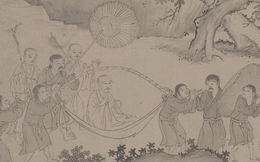| Retired Emperor | |||||||||
|---|---|---|---|---|---|---|---|---|---|
| Chinese name | |||||||||
| Chinese | 太上皇 | ||||||||
| |||||||||
| Vietnamese name | |||||||||
| Vietnamese alphabet | Thái thượng hoàng | ||||||||
| Chữ Hán | 太上皇 | ||||||||
| Korean name | |||||||||
| Hangul | 태상황 | ||||||||
| Hanja | 太上皇 | ||||||||
| |||||||||
| Japanese name | |||||||||
| Kanji | 太上天皇 | ||||||||
| Hiragana | だいじょうてんのう だじょうてんのう | ||||||||
| |||||||||
Retired Emperor, Grand Emperor, or Emperor Emeritus is a title occasionally used by the monarchical regimes in the Sinosphere for former emperors who had (at least in name) abdicated voluntarily to another member of the same dynasty, usually their sons. This title appeared in the history of China, Japan, Korea, and Vietnam. Although technically no longer the reigning sovereign, there were instances like the Qianlong Emperor of the Qing dynasty of China or several emperors of the Trần dynasty of Vietnam, where the retired emperor continued to exert considerable if not more power than the reigning emperor.
YouTube Encyclopedic
-
1/3Views:5 3631 72695 044
-
Japanese History: The Heian Period Pt. 1 (Japanese History: The Textbook)
-
Japanese History: The Heian Period, Pt. 4 (Rule by Retired Emperors)
-
A Samurai Couple, Yoshinaka and Tomoe Gozen (Genpei War Part 3) | History of Japan 62
Transcription
China
The title is named in Chinese as Taishang Huang (Chinese: 太上皇; pinyin: tàishàng huáng; Wade–Giles: T'ai4-shang4 Huang2). The title originated, however, from Liu Bang (Emperor Gao of Han)'s father Liu Taigong,[1] who was honored as such after Liu Bang declared himself emperor in 202, even though Liu Taigong was never emperor himself.
Japan
In Japan the title was Daijō-tennō (kanji: 太上天皇; Hepburn: daijō-tennō), or just Jōkō (kanji: 上皇; Hepburn: jōkō). In Japan, there was a political system called Cloistered rule, in which Jōkō exerted power and influence from behind the scenes even after retirement.
The last Daijō-tennō died in 1840. During the 2019 Japanese imperial transition, the term Jōkō was revived as a special exception to the house law on retirement, and given the official English translation "Emperor Emeritus".
Korea
In Korean the title was Sang-hwang (Hangul: 상황; Hanja: 上皇), or sometimes even Taesang-hwang (hangul: 태상황; hanja: 太上皇). After 1897, when the Joseon dynasty became the dynasty of the Korean Empire, only two emperors were still to ascend to the throne. One was Emperor Gojong, who was forced to abdicate by the Japanese in 1907. However, he was given the title Tae-hwangje (Hangul: 태황제; Hanja: 太皇帝). Another emperor was Emperor Sunjong, but after the Japan-Korea Annexation Treaty of 1910, the Imperial Household was demoted by the Empire of Japan.
Vietnam

In Vietnam the title was Thái thượng hoàng (Chữ Nôm: 太上皇), or just Thượng Hoàng (chữ Nôm: 上皇). Many there have been many prominent Thái thượng hoàng throughout the history of Vietnam, most of them was of the Trần dynasty, one of the golden ages of Vietnam. Trần Thái Tổ (陳太祖) was the first Thái thượng hoàng of the Trần dynasty, the father of Trần Thái Tông (陳太宗) who had great contributions to the rise of the dynasty, was one of two Thái thượng hoàng in Vietnam's history who had not previously been Emperor. Another well-known Retired Emperor is Trần Nhân Tông (陳仁宗) of the same dynasty, whose reign was marked by multiple decisive victories over the invading Mongol-dominated Yuan dynasty, and was also the founder of Trúc Lâm Yên Tử (竹林安子), a Vietnamese zen Buddhist sect. Thái Thượng Hoàng typically hold significant power and influence over the Imperial Court and the governing of the country, though it was not the case for the Revival Lê dynasty, as Trịnh lords held real governing power while the Emperor was only a figurehead, making the power of Retired Emperors even more insignificant.
See also
Notes
- ^ Liu Taigong is a common reference to him, but not his name. His name is disputed.
